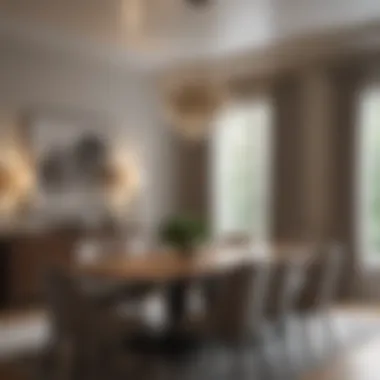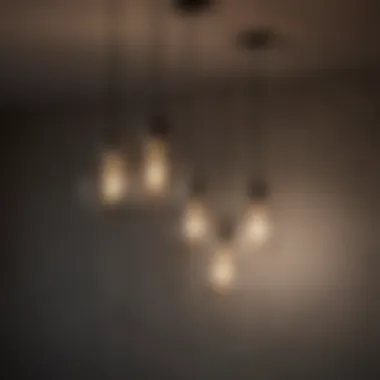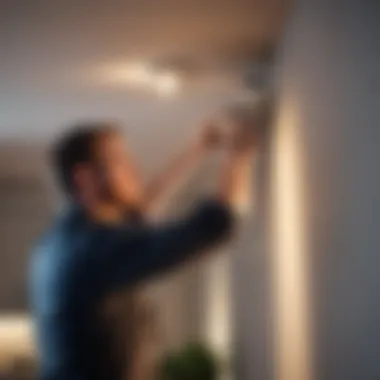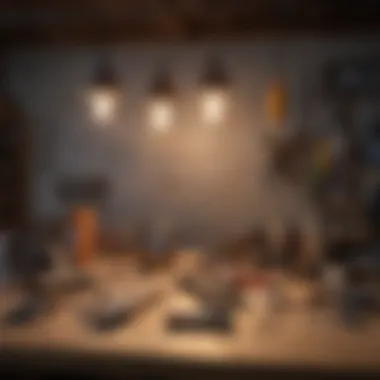Understanding the Cost to Hang a Light Fixture


Intro
Hanging a light fixture is a common task in home improvement projects that can enhance both functionality and aesthetics. Whether you are upgrading an old light, changing the bulb type, or installing something new, understanding the costs associated with this process is crucial.
This guide aims to outline the factors influencing the cost to hang a light fixture. We will consider aspects such as hardware costs, labor expenses, and installation complexity. You will learn how DIY installations compare with hiring a professional, along with regional variations in pricing. Additional elements like electrical upgrades and fixture types will also be examined.
The goal is to empower homeowners, renters, and anyone interested in interior design. We want to provide all the necessary information so you can make educated decisions relating to your living space and budget.
Key Insights and Trends
Current Trends in Interior Design
Interior design continues to evolve, and lighting plays a significant role in setting the mood for a room. Popular styles currently include minimalist and industrial aesthetics. Many homeowners opt for fixtures that incorporate smart technology for energy efficiency. This can affect the overall costs since smart fixtures often come at a higher price point than standard options.
- Minimalist Fixtures: Simple designs that complement modern decor.
- Smart Lighting: Integration of technology for convenience.
- Industrial Styles: Raw materials like metal and exposed bulbs are trendy.
Comparison Between DIY and Professional Installation
Deciding between doing it yourself and hiring a professional can greatly impact the overall cost of hanging a light fixture. DIY installations may be appealing due to potential cost savings but can be time-consuming and risky if you lack experience. Professionals typically charge for labor, which can vary based on location and the complexity of the job.
Practical Tips and How-To Guides
Step-By-Step Guide for Hanging a Light Fixture
If you choose to hang a light fixture independently, here is a basic guide:
- Gather Materials: Ensure you have all necessary tools and the new fixture. Safety gear is a must.
- Turn Off Power: Before starting, switch off the power at the circuit breaker to avoid electric shocks.
- Remove Old Fixture: Carefully detach the existing light fixture. Take note of how it is connected—this will help during installation.
- Install New Fixture: Connect the new fixture as per the manufacturer's instructions.
- Turn On Power: After confirming everything is securely attached, switch the power back on and test the light.
Consider hiring a licensed electrician for fixtures needing electrical modifications.
Additional Considerations
Remember to factor in possible upgrades when hanging your light fixture. Older electrical systems may need an update to support modern lighting, which can add to your costs. Whether going through a professional or opting for a DIY strategy, being informed can help you navigate the complexities of light fixture installation.
Preamble to Light Fixture Installation Costs
Understanding the costs associated with hanging light fixtures is crucial for both homeowners and renters. When you decide to enhance the aesthetic and functionality of a space, knowing the financial implications helps to shape decisions. Appropriate lighting can transform a room, but the process of installing fixtures involves various considerations that directly affect the overall expenditure.
Overview of the Topic
This article explores the ins and outs of light fixture installation costs. It not only highlights the factors contributing to price variations but also provides insights into different types of light fixtures and their specific installation needs. Each element, from the type of fixture to labor costs, plays a significant role in determining how much you will ultimately spend.
Key points to consider include:
- Type of fixture selected
- Installation complexity
- Regional differences in labor charges
- Necessity for additional materials or configurations
Comprehending these factors allows for a clearer expectation of expenditures and helps in effectively managing budgets.
Importance of Understanding Costs
Awareness of installation costs is important for various reasons. First, it aids in proper financial planning, enabling one to allocate sufficient funds for their desired lighting solutions. Additionally, understanding costs can shed light on the potential ramifications of DIY versus professional help. The latter may incur higher expenses but, in many cases, provides peace of mind regarding safety and adherence to electrical codes.
Furthermore, knowing about potential hidden costs—such as the need for electrical upgrades or additional mounting hardware—prepares individuals for unexpected financial burdens. It ensures that once the installation process begins, there are fewer surprises along the way.
Ultimately, informed decisions can lead to better lighting choices that align with both aesthetic desires and budgetary constraints.
Factors Influencing the Cost to Hang Light Fixtures
The cost to hang a light fixture is not simply a matter of the fixture’s price. Various factors play significant roles in determining the total expenses involved in such projects. Understanding these factors allows homeowners to make informed choices, ensuring they select the right options for their needs and budget. Additionally, recognizing the implications of these elements helps in planning for any unexpected costs that may arise during the installation process.


Type of Light Fixture
Different types of light fixtures come with varying price ranges and installation complexities. The choice of fixture impacts not only the initial cost but also its long-term maintenance.
Chandeliers
Chandeliers are often seen as statement pieces in many homes. Their intricate designs and varying sizes can contribute to the overall aesthetic. A key characteristic of chandeliers is their height, which usually requires more complex installation logistics. The benefits of chandeliers lie in their dramatic visual appeal; however, they can be pricier due to their design and the necessity for specialized hardware.
Flush Mounts
Flush mounts are a practical option for low ceilings where space is limited. Their simple design allows for ease of installation, making them a popular choice for many homeowners. They are generally more affordable than chandeliers, reducing overall installation costs. Their primary advantage is their unobtrusive nature, fitting seamlessly into various decor styles.
Pendant Lights
Pendant lights are versatile; they can be used individually or in clusters to create a unique lighting effect. The height at which they hang offers flexibility in design. Due to their popularity in modern decor, they can vary significantly in price. Their installation can be straightforward, but multiple fixtures in one space may increase labor costs.
Wall Sconces
Wall sconces provide ambient lighting and can enhance the atmosphere of a room. They are usually easy to install, often requiring less labor than ceiling-mounted fixtures. Their relatively low cost makes them a favorable choice for enhancing lighting aesthetics without significant expense. However, placement is essential to ensure functionality.
Installation Complexity
The complexity of installation is another critical factor that influences the cost. The more intricate the installation, the more likely it is to incur additional charges. Understanding the different types of installation can help homeowners grasp potential costs.
Standard Installations
Standard installations involve hanging a fixture from an existing electrical source and usually involve minimal changes. This straightforward process generally results in lower labor costs. A benefit of standard installations is that they offer a quick and efficient way to enhance space without extensive renovations.
Recessed Lighting
Recessed lighting requires cutting into ceilings and may involve additional electrical work. While aesthetically pleasing, this complexity often raises installation costs. This method provides a sleek, modern look but may result in multiple visits from an electrician, escalating total expenses.
Hardwiring
Hardwiring is a more complex installation method, often essential for certain types of fixtures. This type requires knowledge of electrical systems, increasing the reliance on professional help. While it provides a clean, permanent solution, the added labor costs can significantly affect the overall expenditure of the project.
Labor Costs
Labor costs can swing the budget for homeowners significantly. Assessing whether to undertake a DIY project or hire professionals is a crucial decision necessary to avoid underestimating expenses.
DIY vs Professional Help
Choosing between doing it yourself and hiring professionals depends on skill and comfort level. DIY options can save money but may lead to safety and compliance issues. On the other hand, hiring a professional ensures proper installation. This choice can prevent costly mistakes and safety hazards down the line.
Hourly Rates for Electricians
Electricians typically charge hourly rates, which may vary depending on their experience and expertise. The investment in a qualified professional can pay off when it comes to ensuring safety and compliance with local regulations. Though rates differ, they often reflect the quality and efficiency of service.
Regional Variations in Labor Costs
Labor costs can fluctuate based on location. Urban settings often command higher rates due to demand and cost of living. Homeowners in rural areas may find lower rates. Being aware of these variations can assist in budgeting accurately for installation projects.
Additional Materials and Equipment
Beyond labor and fixtures, additional materials are often necessary, affecting overall costs. Understanding these components can help in planning and budgeting.
Mounting Hardware
Mounting hardware varies extensively by fixture type and installation requirements. Quality hardware can enhance safety and longevity but may increase total costs. Understanding the necessary components is essential for a smooth installation process.


Wiring
Wiring is another essential consideration. Some installations may require new wiring, especially for fixtures that draw more power. Updating wiring can add to the expense but is crucial for safety and functionality. Additionally, oversight by professionals can ensure that all requirements are met.
Tools Required
Tools required for light fixture installation can vary widely. Some homeowners may need to purchase or rent equipment, raising expenses. However, having the right tools can facilitate a better installation process and reduce labor time.
Understanding these various factors influencing costs will provide a clearer picture for homeowners. Adequate preparation and awareness of potential expenses will guide informed decisions regarding the installation of light fixtures.
Cost Breakdown for Light Fixture Installation
Understanding the cost breakdown for light fixture installation is crucial for homeowners and renters alike. This section serves to outline the various components that contribute to the overall expense involved in hanging a light fixture. A clear breakdown can assist individuals in budgeting effectively and making informed choices. By grasping the nuances of costs associated with materials, labor, and installation complexity, decision-making becomes more straightforward.
The key benefits of knowing the cost breakdown include the ability to prioritize where to allocate resources, estimate potential savings with DIY approaches, and assess the value of hiring a professional electrician versus taking on the project oneself. These insights can mitigate unexpected expenses or delays during the installation process, as they prepare individuals for the financial implications of their lighting choices.
Typical Cost Ranges
When considering the typical cost ranges for light fixture installations, it is essential to factor in both the fixture itself and the associated installation costs. On average, homeowners may expect to see costs ranging from $50 to $1000 or more. Costs vary greatly due to brand, material, and size, along with the intricacy of installation requirements.
- Basic Fixtures (e.g., flush mount, simple ceiling lights): $50 - $150
- Mid-Range Fixtures (e.g., pendant lights, attractive wall sconces): $150 - $500
- High-End Fixtures (e.g., large chandeliers, designer lamps): $500 - $1000+
In addition to the cost of the fixture, the installation adds significant expense. Simple installations may cost between $100 and $200, while more complex jobs, such as hardwiring fixtures, can exceed $400 due to labor and additional materials.
Comparative Costs for Different Fixture Types
A variety of light fixture types exist, each carrying its own cost implications in terms of purchase and installation. Understanding the comparative costs among different fixture types allows for a more educated selection based on aesthetic goals, budget constraints, and functionality.
- Chandeliers tend to be more expensive both for the fixture and installation. They can require special handling and often need reinforcement of the mounting area. Installation costs can range from $200 to over $600.
- Flush Mounts are simpler and generally cheaper to install, thanks to their lightweight structure, costing between $50 and $150 for the fixture and $100 to $200 for installation.
- Pendant Lights can vary widely in style and cost. Simple pendant lights may only cost $100, with installation typically around $150, but designer or multi-light pendants can push costs higher.
- Wall Sconces often provide a mid-range option, typically costing $100 to $300 for the fixture, and installation ranging from $100 to $250 depending on wiring and placement.
This comparative overview underscores the importance of choosing not just based on aesthetics but also considering the long-term costs associated with each type of light fixture.
DIY Light Fixture Installation Considerations
When it comes to hanging light fixtures, many homeowners face a choice: to install the fixture themselves or to hire a professional. This section hones in on the DIY approach, exploring its appeal as well as its potential drawbacks. Understanding both benefits and challenges of DIY light fixture installation is crucial for making the right decision based on one’s skill level, comfort with electrical work, and the complexity of the task at hand.
Benefits of DIY Installation
One of the most compelling arguments for DIY installation of light fixtures is cost savings. By choosing to install the fixture yourself, you can eliminate the labor costs associated with hiring an electrician, which can significantly increase the overall price. Furthermore, many people enjoy the intrinsic satisfaction that comes from completing a home improvement project on their own. It allows for a sense of ownership and pride in transforming one’s living space.
Additionally, the convenience of DIY installation cannot be overlooked. For some, the prospect of waiting for an electrician’s availability is not desirable. If you have a specific vision in mind and can act on it quickly, doing it yourself means you can begin your project on your schedule rather than according to someone else's timeframe.
Challenges and Risks
Despite the advantages of taking a DIY approach, there are also several challenges and risks associated with it. It is essential to weigh these carefully before proceeding with the installation.
Safety Concerns
Safety concerns rank highly in terms of importance during any electrical installation. Electrical work can be hazardous, especially if one is not familiar with the intricacies of wiring and connections. Even minor mistakes can lead to severe consequences, including electrocution or fire hazards. The key characteristic here is that knowledge and preparation play pivotal roles in ensuring safety. Therefore, homeowners should consider their comfort level and understanding of electrical systems. While DIY installation can be appealing, one must be aware of the risks and take the necessary precautions to mitigate them.
Code Compliance
Code compliance refers to the necessity of adhering to local building and electrical codes when performing any electrical work. These codes are designed to ensure safety and functionality. This aspect is critical, as failing to comply can result in serious fines or have implications when selling the home in the future. The unique feature of code compliance in this context is its enforceability; local authorities can inspect work and mandate adherence to certain standards. Thus, while DIY can save money, it necessitates a thorough understanding of local regulations and the code’s application.
Potential for Errors
Another significant consideration is the potential for errors during installation. Mistakes can lead to various issues, from functionality problems, like flickering lights, to more severe operational failures. The key characteristic of errors is their unpredictability. For those without considerable experience in electrical projects, the potential for missteps increases, which could lead to a need for professional repairs later on. Therefore, this aspect emphasizes the need for a clear understanding of the installation process and the skills required before diving into such projects.
In summary, DIY light fixture installation offers numerous benefits but also presents notable challenges and risks. By carefully considering these aspects, homeowners can make informed decisions that align with their skills and comfort levels.


Hiring a Professional Electrician
Hiring a professional electrician for light fixture installation is a pivotal element in ensuring the job is done correctly and safely. This section will explore the reasons why this consideration is essential and what to expect when looking for a qualified electrician.
Why to Consider Professional Help
Opting for professional help is often the best choice for light fixture installation. This is mainly due to the technical knowledge and experience that licensed electricians bring to the table. They understand local electrical codes and can ensure that installations adhere to all safety standards. Furthermore, professional electricians can also spot underlying issues within an electrical system. These problems, if left unchecked, could lead to unsafe conditions or increased expenses in the future. Many people underestimate the risks involved in DIY installations, which can occasionally lead to electrical failures or even fires. The importance of hiring an expert cannot be understated when safety is on the line.
What to Look for in an Electrician
When searching for an electrician, it is crucial to consider two primary aspects: qualifications and reputation. The right combination of these factors ensures that you hire a capable and trustworthy professional for your installation needs.
Qualifications and Experience
The qualifications and experience of an electrician play a significant role in determining their ability to perform quality work. A licensed electrician should have completed an accredited training program, which usually involves apprenticeships and specialized studies. This foundational knowledge allows them to tackle various installation challenges effectively. A more experienced electrician is often preferred because they have dealt with different types of fixtures and installations before. They can offer solutions that a less experienced installer might miss.
"Experience is not just about how long someone has worked; it's about the range of scenarios they have encountered."
Moreover, having proper certifications demonstrates a commitment to their craft and indicates that they stay updated on new technologies and techniques. This ability to adapt is a key characteristic in the ever-evolving field of electrical work, making qualified electricians a worthwhile investment.
Reputation and Reviews
Reputation and reviews serve as a vital indicator of an electrician's competency and reliability. When approaching this area, the key characteristic to focus on is the feedback from previous clients. Positive reviews generally showcase the electrician’s ability to complete tasks efficiently and effectively. People often share their experiences, which can help potential clients feel more confident in their selection.
One unique feature of checking reputation is the use of online platforms where customers leave reviews. Websites such as Yelp or Angie's List can provide insight into an electrician's past work. This aspect allows for a broader understanding of potential hires, revealing strengths and weaknesses based on customer feedback. Therefore, a well-reviewed electrician is likely to be a safer choice for your installation.
In summary, hiring a professional electrician not only enhances safety but also improves the quality of installation. It is crucial to consider their qualifications and experience, along with their reputation and reviews, to make an informed choice.
Epilogue: Making an Informed Decision
When considering installation, knowing the factors at play enables you to budget effectively. The insights gained herein reveal how sometimes the cheapest option may lead to unforeseen costs down the line. Additionally, comprehending DIY versus hiring professionals can impact the final outcome of your project. Thus, taking a moment to reflect on the details discussed will lead to a more satisfying installation experience.
Summarizing Key Points
Various aspects play a substantial role in determining the cost of hanging light fixtures. Here are the key points to remember:
- Type of Fixture: Different fixtures, such as chandeliers, flush mounts, and pendants, carry varying price tags.
- Installation Complexity: Standard installations are usually less costly compared to more intricate setups, like recessed lighting or hardwiring.
- Labor Costs: Assessing whether to take the DIY route or hire a professional can significantly affect your budget.
- Materials and Equipment: The cost of additional items, like mounting hardware, wiring, and tools, should not be omitted from your financial considerations.
Final Considerations Before Installation
Before you commit to your lighting project, a few final thoughts may help ease the decision-making process:
- Budgeting Wisely: Take into account not only the price of the light fixture but also installation expenses.
- Safety and Compliance: Ensure any installation complies with local building codes, especially when working with electricity.
- Long-Term Investment: Quality fixtures may seem more expensive upfront but can provide value through aesthetics and durability over time.
- Installation Timing: Evaluate whether this project fits into your overall home improvement timeline.
Ultimately, every decision you make regarding light fixtures contributes to the overall ambiance of your home. Prioritize your choices carefully, and you will achieve the desired lighting while maintaining control over costs.
Further Resources and References
Understanding the costs associated with hanging light fixtures is crucial for homeowners as it influences decision-making. This section serves to highlight the importance of having access to additional resources and references. These elements supplement the discussion in the article and provide clarity on various topics, from installation to legal compliance.
Accessing reliable resources helps readers gain deeper insights into light fixture installation processes and related costs. It can assist in avoiding common pitfalls, ensuring safety, and complying with local regulations. Moreover, understanding industry standards fosters confidence, whether one chooses to pursue a DIY approach or hire a professional.
Helpful Guides and Tools
For those looking to install light fixtures, several guides and tools are available to facilitate this process. These resources range from detailed step-by-step instructions to calculators that estimate costs based on specific requirements.
- Installation Guides: Detailed manuals from manufacturers often provide essential steps tailored to particular light fixtures. These can be invaluable for ensuring that installations are executed correctly.
- Cost Estimation Tools: Online platforms allow users to input various parameters to receive estimated installation costs. This transparency aids in budgeting accurately.
- Safety Checklists: Before beginning any installation, these lists can help ensure that all safety measures are observed. Basic checks may include the condition of existing wiring and the need for circuit breaker upgrades.
"Reliability of resources can significantly minimize the risk of error in installation and enhance overall safety."
Industry Standards and Regulations
Familiarity with industry standards and regulations is vital for anyone considering light fixture installation. These standards often dictate how installations should be performed to ensure safety and efficiency. Additionally, they can vary based on location, necessitating careful attention.
- Electrical Codes: Most regions have electrical codes regulating installation practices. Understanding these codes helps avoid costly fines and ensures compliance.
- Safety Guidelines: Guidelines from electrical safety organizations outline essential practices to prevent hazards. These might include requirements for grounding and circuit protection.
- Local Building Codes: Many areas require permits for certain electrical work, including light fixture installations. Awareness of these requirements can prevent delays and setbacks during the installation process.
Utilizing these further resources and references not only empowers decision-making but also promotes a more informed approach toward the cost of hanging light fixtures.



